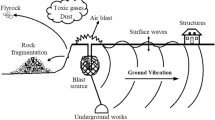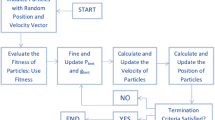Abstract
This paper deals with the application of genetic algorithm (GA) optimization technique to predict peak particle velocity (PPV). PPV is one of the important parameters to be determined to minimize the damage caused by ground vibration. A number of previous researchers have tried to use different empirical methods to predict PPV but these empirical methods have their limitations due to their less versatile application. In this paper, GA technique is used for the prediction of PPV by incorporating blast design and explosive parameters and the suitability of one technique over other has been analyzed based on the results. Datasets have been obtained from one of the Kurasia mines. 127 data sets were used to establish GA architecture and 10 data sets have been used for validation of GA model to observe its prediction capability. The results obtained have been compared with different traditional vibration predictors, multivariate regression analysis, artificial neural network and the superiority of application of GA over previous methodology have been discussed. The mean absolute percentage error in the proposed architect is very low (0.08) as compared to other predictors.




Similar content being viewed by others
References
Adhikari GR (1999) Burden calculation for partially changed blast design conditions. Int J Rock Mech Min Sci 36(2):253–256
Afrouz A, Hassani FP, Ucar R (1988) An investigation into blasting design for mining excavations. J Min Sci Technol 7:45–62
Ambraseys NR, Hendron AJ (1968) Dynamic behaviour of rock masses. In: Rock mechanics in engineering practices. Wiley, London, pp 203–207
Blair DP (1993) Blast vibration control in the presence of delay scatter and random fluctuations between blast holes. Int J Numer Anal Methods Geomech 17(2):95–118
Duvall WI, Fogleson DE (1962) Review of criteria for estimating damage to residences from blasting vibration. USBM-I, 5968
Ghosh A, Daemen JK (1983a) A simple new blast vibration predictor. In: Proceedings of 24th US symposium rock mechanics, Texas, pp 151–161
Ghosh A, Daemen JK (1983b) A simple new blast vibration predictor (based on wave propagation laws). In: Proceedings of 24th US symposium on rock mechanics, Texas
Indian Standard Institute (1973) Criteria for safety and design of structures subjected to underground blast, ISI Bulletin, IS 6922
ISRM (1992) Suggested method for blast vibration monitoring. Int J Rock Mech Min Sci Geomech Abstr 29:145–146
Langefors U, Kihlstrom B (1978) The modern technique of rock blasting. Wiley, New York
Luger GF (2002) Artificial intelligence, structures and strategies for complex problem solving, 4th edn. Addison-Wesley, Harlow, p 471
Narayana VL, Mohan S (1996) Control of Flyrock for improving Safety in Opencast mines. Minetech 17(5):49–64
Nicholls HR, Johnson CF, Duvall WI (1971) Blasting vibrations and their effects on structures. Bulletin 656. US Bureau of Mines, Washington, DC, p 105
Pal Roy P (1993) Putting ground vibration prediction into practice, vol 241, issue 2. Colliery Guardian, UK, pp 63–67
Rai R, Singh TN (2004) A new predictor for ground vibration prediction and its comparison with other predictors. Ind J Eng Mat Sci 11:178–184
Rajasekaran S, Pai GAV (2003) Neural networks, fuzzy logic and genetic algorithms synthesis and applications. Prentice-Hall, Englewood Cliffs, p 227
Roy PP, Dhar BB (1993) Comparative assessment of ground vibration and fragmentation in three iron ore deposits in Inida. Proceedings, Vienna, Austria, pp 287–294
Rustan A (1992) Burden, spacing and bore hole diameter at rock blasting. Int J Surf Min Reclam 6:141–149
Singh TN (2004) Artificial Neural Network approach for prediction and control of ground vibrations in mines. Min Technol (Trans Inst Min Metall A) 113:A251–A257
Singh TN, Singh V (2005) An intelligent approach to prediction and control ground vibration in mines. Geotech Geol Eng 23:249–262
Singh AP, Singh TN (2006) Assessing instability of coal mine waste dump. Indian Miner Ind J 113–118
Singh MM, Singh RB, Bagchi A, Dhar BB (1993) Report on study on deep hole blasting at Kurasia open cast mine to contain ground vibration and flyrock within same limit. CMRS. Technical report, pp 5–10
Singh TN, Kanchan R, Saigal K, Verma AK (2004) Prediction of P-wave velocity and anisotropic properties of rock using Artificial Neural Networks technique. J Sci Ind Res 63(1):32–38
Singh TN, Kanchan R, Verma AK (2004) Prediction of blast induced ground vibration and frequency using an artificial intelligence technique. Int J Noise Vibration Worldwide Multi Sci Publ UK 35(11):7–14
Siskind DE, Stagg MS, Kopp JW, Dowding CH (1980) Structure response and damage produced by ground vibration from surface mine blasting. USBM RI 8507, p 74
Wiss JF, Linehan PW (1978) Control of vibration and air noise from surface coal mines—III. Bureau of Mines, US, Report No. OFR, vol 103, issue 3, p 79
Author information
Authors and Affiliations
Corresponding author
Rights and permissions
About this article
Cite this article
Verma, A.K., Singh, T.N. Intelligent systems for ground vibration measurement: a comparative study. Engineering with Computers 27, 225–233 (2011). https://doi.org/10.1007/s00366-010-0193-7
Received:
Accepted:
Published:
Issue Date:
DOI: https://doi.org/10.1007/s00366-010-0193-7




